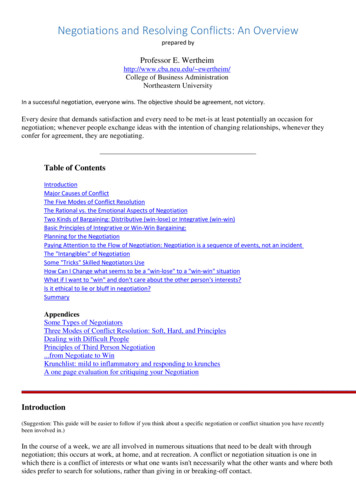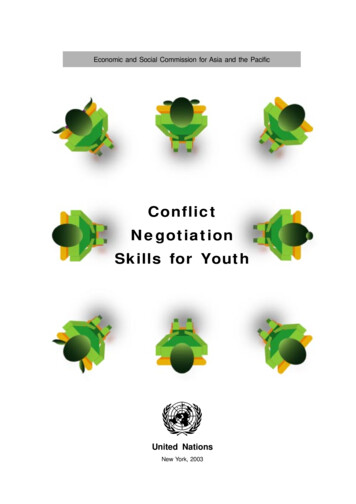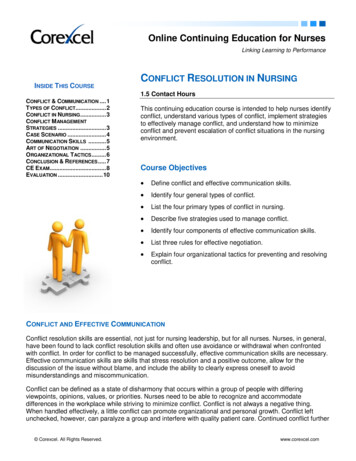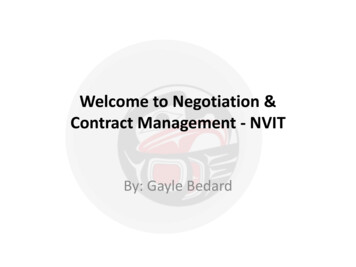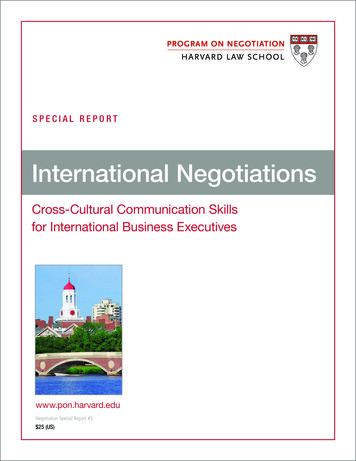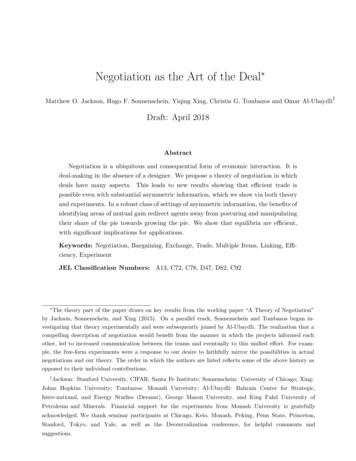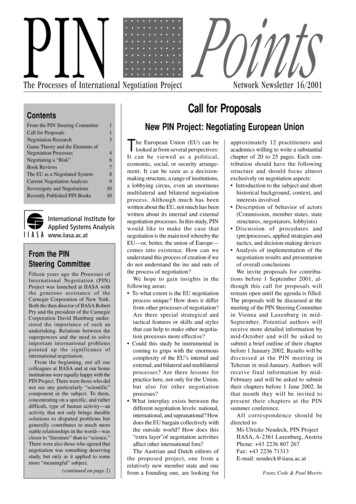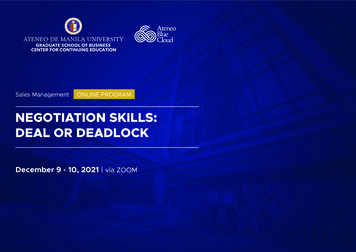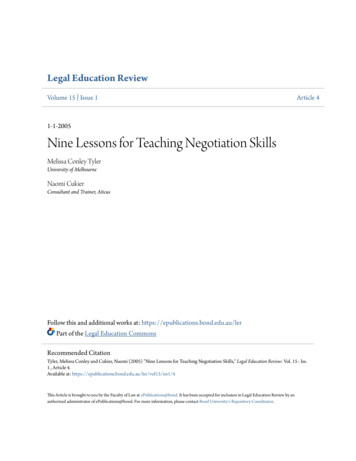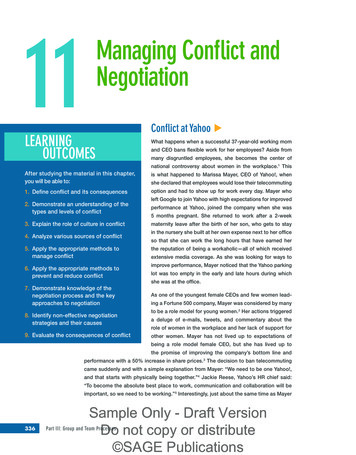
Transcription
11Managing Conflict andNegotiationLEARNINGOUTCOMESConflict at YahooWhat happens when a successful 37-year-old working momand CEO bans flexible work for her employees? Aside frommany disgruntled employees, she becomes the center ofnational controversy about women in the workplace.1 ThisAfter studying the material in this chapter,you will be able to:is what happened to Marissa Mayer, CEO of Yahoo!, when1. Define conflict and its consequencesoption and had to show up for work every day. Mayer who2. Demonstrate an understanding of thetypes and levels of conflict3. Explain the role of culture in conflict4. Analyze various sources of conflict5. Apply the appropriate methods tomanage conflict6. Apply the appropriate methods toprevent and reduce conflict7. Demonstrate knowledge of thenegotiation process and the keyapproaches to negotiation8. Identify non-effective negotiationstrategies and their causes9. Evaluate the consequences of conflictshe declared that employees would lose their telecommutingleft Google to join Yahoo with high expectations for improvedperformance at Yahoo, joined the company when she was5 months pregnant. She returned to work after a 2-weekmaternity leave after the birth of her son, who gets to stayin the nursery she built at her own expense next to her officeso that she can work the long hours that have earned herthe reputation of being a workaholic—all of which receivedextensive media coverage. As she was looking for ways toimprove performance, Mayer noticed that the Yahoo parkinglot was too empty in the early and late hours during whichshe was at the office.As one of the youngest female CEOs and few women leading a Fortune 500 company, Mayer was considered by manyto be a role model for young women.2 Her actions triggereda deluge of e-mails, tweets, and commentary about therole of women in the workplace and her lack of support forother women. Mayer has not lived up to expectations ofbeing a role model female CEO, but she has lived up tothe promise of improving the company’s bottom line andperformance with a 50% increase in share prices.3 The decision to ban telecommutingcame suddenly and with a simple explanation from Mayer: “We need to be one Yahoo!,and that starts with physically being together.”4 Jackie Reese, Yahoo’s HR chief said:“To become the absolute best place to work, communication and collaboration will beimportant, so we need to be working.”5 Interestingly, just about the same time as Mayer336Sample Only - Draft VersionDo not copy or distribute SAGE PublicationsPart III: Group and Team Processes
Creativity comes from a conflict of ideas.—Donatella VersaceSample Only - Draft VersionDo not copy or distribute SAGE PublicationsChapter 11: Managing Conflict and Negotiations337
Conflict cannot survive without yourparticipation.—Wayne DyerOne of the greatest powers we have in anegotiation is the power to NOT react.banned t elecommuting, another company, BestBuy—headed by a male CEO—ended its ownpioneering flexible work-from-home program.6Little controversy ensued in that case. Alsoreleased around the same time were severalreports about the benefits of telecommuting toboth employees and company bottom lines.—William UryWhen people with different goals and interests work together, the potential for disagreement is always present. This disagreement or conflict may be about personal preferences,political differences, or organizational policies and procedures. It may reside largely belowthe surface, but it also may break into the open—sometimes at the oddest times—and, onoccasion, latent conflict may explode into sheer nastiness. Similarly, negotiating with others to reach or deal or to resolve conflict is also part of all relationships inside and outsideorganizations. You may experience conflict with a friend, a classmate, a coworker, a supervisor, or a subordinate. In organizations, as in personal relationships, managing conflictconstructively and negotiating well are essential.Most students of organizations view conflict as inevitable.7 Negotiating to resolve suchconflict or to make deals is an inherent part of a manager’s job. In addition, the currenttrends toward workforce diversity, globalization, and partnerships with other organizations are making increasingly important the way in which managers from different organizations and cultures deal with conflict and negotiate.Defining ConflictConflict is a process in which people disagree over significant issues, thereby creating friction. For conflict to exist, several factors must be present: People must have opposing interests, thoughts, perceptions, and feelings Those involved must recognize the existence of different points of view The disagreement must be ongoing rather than a singular occurrence People with opposing views must try to prevent one another from accomplishing their goals.Conflict: a process inwhich people disagreeover significant issues,thereby creating frictionConflict can be a destructive force. However, it can also be beneficial when used as asource of renewal and creativity. Before we look at views, sources, consequences, and waysto manage conflict, note that we often use the terms conflict and competition interchangeably, although the two differ. Competition is the rivalry between individuals or groupsover an outcome and always has a winner and a loser. While competition can be one of thesources of conflict, conflict does not necessarily involve winners and loser; we can haveconflict over issues, but cooperate so that no one loses or wins.Competition: rivalrybetween individuals orgroups over an outcome;always has a winner anda loser338Views of ConflictThere are two general views of conflict. First, conflict can be considered a negative forceand dysfunctional—that it makes people feel uncomfortable and, consequently, makesSample Only - Draft VersionDo not copy or distribute SAGE PublicationsPart I: Group and Team Processes
SELF-ASSESSMENT 11.1HOW DO YOU BEHAVE DURING CONFLICT?The following questions provide additional insight into how you behave in conflict situations.8 Answer eachquestion as to the extent that you think or believe that the statement is true.Never SeldomOccasionallyUsuallyAlways1. Do you believe that in every conflict situation,mutually acceptable solutions exist or are available?123452. Do you believe that in each conflict situation,mutually acceptable solutions are a desirable thing?123453. Do you favor cooperation with all others in youreveryday activities and disfavor competition withthem?123454. Do you believe that all people are of equal valueregardless of age, race, religion, culture, or gender?123455. Do you believe that the views of others are legitimate(i.e., genuine, accurate, true) expressions of theirpositions?123456. Do you believe that differences of opinion are helpfuland beneficial?123457. Do you believe that others are worthy of your trust?123458. Do you believe that others can compete but that theyalso can choose to cooperate?123459. Do you believe that how one thinks and how onefeels are factors in deciding how one behaves?12345After answering these questions, go back and reflect on your answers. For example, are you more likely toaccommodate or avoid confrontations? What else did you learn? You should revisit these questions afteryou have finished reading this chapter.Source: Lulofs, S., & Cahn, D. D. (2000). Conflict: From theory to action (2nd ed.). Boston, MA: Allyn & Bacon, p. 36.them less productive. Second, conflict can be viewed as a natural part of organizational lifeand beneficial to the workplace.9Early views of management considered conflict to be dysfunctional. For example, one ofthe fathers of management, Frederick Taylor (see Chapter 1), viewed conflict as a threatto managerial authority and as a waste of time. According to his view, conflict can causeunnecessary stress, reduce communication and group cohesion, and prevent employeesfrom focusing on their task. Many of you have experienced the negative impact of conflict when infighting and personality conflicts create intense animosity that made it hard toSample Only - Draft VersionDo not copy or distribute SAGE PublicationsChapter 11: Managing Conflict and Negotiations339
work cooperatively with coworkers. Organizational psychologist David Javich suggests that many people hold inaccurate beliefs about conflict, what he calls conflict myths.10These include the belief that conflict will destroy team cohesion, make cooperation impossible, and that it will cause anunmanageable chain reaction in organizations.We already have noted that the environment in which today’sorganizations operate is highly turbulent and often chaotic.Actually, organizations in which there is a little disagreement and well-managed conflict are more likely to do wellin such environments. As a matter of fact, some researcherssuggest that too much agreement can lead to complacencyand can be destructive.11 Members are either so homogeneous that they are ill equipped to adapt to changing environmental conditions, or so complacent that they see no needto improve the status quo. Indeed, a positive view of conflictargues that it is the very lifeblood of vibrant, progressive, andstimulating organizations because it sparks creativity, fostersinnovation, and encourages personal improvement.12As with most organizational processes we have discussed sofar, conflict is neither all good nor all bad. Some levels andGlobalization has increased the frequency of cross-cul- types of conflict are healthy; others are not. Figure 11.1tural communication, conflict, and negotiations.shows how moderate levels of conflict stimulate creativedecision making and prevent groupthink and apathy. Very low conflict levels lead to complacency and stagnation. Very high levels, especially if based on individual and personality differences rather than issues related to organizational goals and processes, are detrimental tothe organization, and cause dysfunctional behavior. The level and type of conflict and how itis managed determine whether it is beneficial or detrimental to the organization.FIGURE 11.1CONFLICT AND thy disagreementDiscussion of ideasComplacencyGroupthinkLowLowIn-fightingLack of cooperationMediumHighLevels of conflict340Sample Only - Draft VersionDo not copy or distribute SAGE PublicationsPart I: Group and Team Processes
Managers should expect intelligent, well-trained, and motivated employees to disagreeover a variety of issues. In fact, employees agreeing easily on how to approach any issue ofimportance to a company may signal trouble. By the same token, constant disagreementsover every issue, or personal conflict, are dysfunctional and destructive. The ability to generate disagreement might be a hallmark of the effective decision maker, but we should notethat generating conflict requires considerable maturity and self-confidence on the part ofthe manager; many managers feel too insecure to stir up conflict among their subordinates.By managing conflict properly, a manager can mobilize disparate pieces of information anddiverse perspectives into productive solutions. For this reason, conflict presents opportunities for mobilizing ideas and approaches in the organization and can promote increased creativity, innovation, flexibility, and responsiveness as well as generally improve the overalleffectiveness of the organization. Conflict forces people to test and assess themselves and, asa result, stimulates interest and curiosity in others, promoting productive change.Consequences of ConflictClearly, conflict has both positive and negative consequences, as we see in Figure 11.2. Onthe positive side, all of us have experienced the exhilaration and energy that come fromcompetition. Competition and conflict can motivate people and inspire them to focus onthe task. Involvement in competition brings group members closer together and leads toincreased discussions of various issues and alternatives. When outside conflict or competition occurs, groups members band together and brainstorm to find creative solutions. Thisprocess increases group cohesion and effectiveness.Companies can use competition with other companies as a way of reducing internalconflict and focusing the employees’ energies on outside competitors. Although conflictis inevitable and desirable in organizations, a high level of unresolved conflict can bedestructive. Individuals, teams, or departments that are engaged in high conflict may losesight of the common goals and focus on winning at all costs. They could withhold important information from others, or even actively sabotage others’ work. When conflict leadsto winners and loser, losers may be demoralized and become demotivated. Consider anorganization that sets up a competition among four teams for the design of a new service.The team that wins receives accolades and rewards; the losers are ignored or even punished. At the outset of the competition, all teams may be strongly motivated to win, sothey work hard on their task and creativity is likely to be high. However, when the manager announces the winner, the remainingthree teams lose their motivation to conFIGURE 11.2tribute. This loser effect harms long-termrelationships and overall organizational performance.CONSEQUENCES OF CONFLICTIdeally, managers are proactive in creatingan environment in which the likelihood ofdysfunctional conflicts is minimized as thediversity of contributions and talents ofothers are appreciated.13 When conflict isnot resolved or reaches levels that are toohigh, managers risk letting differing perspectives go undirected, often resulting intension and dysfunction rather than creative and progressive change.BENEFITSDISADVANTAGES High energy Focus on the task Stimulateinnovation Increased in-groupcommunication In-group cohesion Discussion of issues Focus on conflict Concern withwinning at all costs Distorted judgment Lack of cooperation Loser effectSample Only - Draft VersionDo not copy or distribute SAGE PublicationsChapter 11: Managing Conflict and Negotiations341
Types and Levels of ConflictTable 11.1 summarizes the four types of conflict that managers encounter. Intrapersonalconflict is a person’s internal conflict. For example, a father who wants to be heavilyinvolved in his young children’s school activities and to be on the corporate fast trackmay experience intrapersonal conflict. His goals and values regarding family conflict withhis goals as a manager. Interpersonal conflict refers to conflict that arises between two ormore people who are required to interact and who have different goals, values, or styles.This is the type of conflict we often call “personality conflict.” Because such conflict typically revolves around personal differences rather organizational goals, the potential fornegative impact is high and it can be problematic for managers.TABLE 11.1Type of ConflictDescriptionIntrapersonalWithin a person, because he or she is motivated to engage in two or more activities that are incompatibleInterpersonalBetween two or more people who interact and have incompatible goals, styles, orvaluesIntragroupWithin a group when members disagree over group goals, activities, leadership,or processesIntergroupBetween different groups, departments, or divisions that disagree over task,processes, resources, or informationIntrapersonalconflict: a person’sinternal conflictInterpersonalconflict: conflict thatarises because two ormore people who arerequired to interact havedifferent goals, values,or stylesIntragroup conflict:conflict within a workgroup over goals or workproceduresIntergroup conflict:when groups within andoutside an organizationdisagree over varioustopicsHorizontal conflict:between departments orgroups at the same levelof the organization342TYPES OF CONFLICTIntragroup conflict refers to conflict within a work group over goals or work procedures.While some level of intragroup conflict is healthy and helps prevent problems such asgroupthink, this type of conflict, if not well managed, can be extremely detrimental togroup cohesion and productivity. As you read in Chapter 10, all groups and teams facesome conflicts, particularly in the early stages of development. Navigating these conflictssuccessfully is an important aspect of a group’s maturity and a predictor of its success.Finally, intergroup conflict occurs when groups within and outside an organization disagree over various topics. Intergroup conflict is usually about broad organizational issuessuch as resource allocation, access to information, and system-related processes. Forinstance, departments in most organizations face conflict over the allocation of resourcesduring budget negotiations, each vying for a larger share of the pie. Or key departmentsmay disagree as to how a product should be designed or marketed. Intergroup conflictoccurs at different organizational levels. Horizontal conflict takes place between departments or groups at the same level of the organization. As departments work together toachieve organizational goals, they may disagree over schedules, quality, efficiency, andso forth. Sales and production departments often conflict over production and deliveryschedules. Sales people promise customers certain delivery dates without double-checkingthe production schedule. When the sales team learns of product delays, conflict results.As you will learn in Chapter 14, proper management of horizontal conflict is essential forintegration of activities within an organization.Vertical conflict occurs between groups at different levels of the hierarchy. It typically involvesbroad organizational issues of control and power. A department may have a conflict withtop executives over the allocation of resources for raises. Another vertical conflict may ariseSample Only - Draft VersionDo not copy or distribute SAGE PublicationsPart I: Group and Team Processes
because managers want autonomy to stay flexible and responsive to local customers’ needs butheadquarters wants to control and standardize procedures to monitor costs. Understandingthe type and level of conflict is the first step for managers to manage conflict well.Culture and ConflictCulture is one factor that determines how people handle and view conflict. Individuals’dispositions are rooted in their early social and cultural experiences, and, because conflictis an interpretive behavior, culture shapes people’s interpretation of behavior and theirstyle of interaction with others. Therefore, cultural values create a social environment thatencourages members to select some behaviors over others.Some cultures are more tolerant and accepting of conflict than others who tend to view itas a sign of trouble. Any cross-cultural contact has the potential for conflict because people from different cultures often have different values and goals. Any differences in goalsor values can lead to conflict, so we cannot identify all those differences here. It thus is notsurprising that research has also found that strategies for negotiating conflict vary according to one’s cultural background and cultural values.14 Collectivist cultures such as those ofAsian, Middle Eastern, and Latin American countries tend to adopt a harmony perspectiveon conflict.15 Individualistic cultures in English-speaking countries are more likely to use aconfrontational approach.16 Eastern European and Hispanic countries are likely to adopta regulative model of conflict, which relies on bureaucracy and organizational structure tocontain conflict.17 A study of businesspeople in Japan, Germany, and the United States foundthat the Japanese used power strategies more than Germans, who used more power thanAmericans.18 Generally, people in individualistic cultures, such as that of the United States,value and encourage competition. In collectivist cultures, characteristic of many Asian andLatin American countries for example, people focus on the community and consensus. Thus,in collectivistic cultures, managers are more likely discourage competition to reduce conflict.Social status and gender, group-level cultural factors, will also influence individuals’choice of conflict management strategies.19 For example, avoiding disputes or refrainingfrom direct confrontation with conflict issues in a formal or public sphere has been foundto be a prevailing mode of conflict management by low-status individuals and members ofminorities.20 Additionally, research on gender and conflict resolution found that femininity was significantly related to the use of an accommodative style in conflict resolution,while masculinity was related to the competitive style.21The culture of an organization can also act in much the same way as national or group culture. Anorganization based on individual achievement and competition will encourage conflict, whereasone based on cooperation and group consensus is likely to discourage conflict. Furthermore,because of the leader’s impact on culture, a leader’s conflict management style, which we discusslater in this chapter, can affect how the organization as a whole views and manages conflict.Sources of ConflictConflict can arise because of both personal and organizational sources (see Figure 11.3). While itis not always easy to separate the two, some conflicts are more directly related to individuals having incompatible goals or values while others are related to the way the organization is structuredor managed.Sample Only - Draft VersionDo not copy or distribute SAGE PublicationsVertical conflict:between groups atdifferent levels of thehierarchyChapter 11: Managing Conflict and Negotiations343
FIGURE 11.3SOURCES OF pendencePersonal Sources of ConflictPersonal sources of conflict are often interpersonal in nature and cover many differentgrounds.22 For example, two coworkers may have different work styles, or an employeemay want more autonomy than her manager is willing to give her. These sources of conflict often involve individual perceptions and expectations about how the work shouldbe done and what is important in the work environment. They are influenced by the personality, style, and culture of the individual. Because they involve individual values, conflicts based on personal differences tend to be highly emotional and difficult to resolve. Forexample, a devout Catholic business owner might have difficulties locating his businessnear a Planned Parenthood clinic where abortions are performed. A disagreement aboutlocation may turn into a bitter argument about who is morally correct.Perception may also lead to personal differences. Differing perceptions alone may beenough to invite conflict. An employee may perceive that he is not valued by his supervisorbecause he does not receive regular praise for his efforts. The supervisor values his workand believes he is making excellent contributions in a tough financial environment. However, she is internally motivated, does not personally have theneed for constant praise, and does not see the point of praisingher employee often. The conflict is caused by how each personperceives the situation.What Do You Think?Some managers try to control conflict tomaintain smooth operations. Others stimulatedisagreements, hoping to get all sides of theissue. Both strategies make some sense. Whatdo you think? Which strategy are you mostcomfortable using? Why?344Many conflicts caused by cross-cultural differences are furtherrelated to differences both in values and in perception. Sinceculture influences what people value, it is not surprising thatculture can be a factor in personal sources of conflict in organizations. A Mexican manager may perceive his North Americanemployee who calls him by his first name and interrupts him inmeetings to disagree with him to be rude and disrespectful. Theemployee is simply behaving according to his cultural valuesSample Only - Draft VersionDo not copy or distribute SAGE PublicationsPart I: Group and Team Processes
that suggest openness and participation. Similarly,a Thai employee who comes from a culture thatvalues indirectness and avoiding conflict may findher European manager’s honest and direct performance review or her North American team members’ open disagreement offensive, causing conflictand leading to lack of motivation.Organizational Sources of ConflictSometimes we attribute conflict to personal factors, where organizational structures and processesmay really be the source. For example, we maythink a coworker is uncooperative and unhelpfulby nature while the organization’s reward systemthat encourages competition may be to blame. Weconsider five organizational sources of conflict (seeFigure 11.3).Managers from masculine cultures are likely to be more assertiveand independent, a potential cause of conflict when working withthose from cultures that value indirectness or cooperation.Goal IncompatibilityGoal incompatibility is the source of many conflicts. Because different departments inorganizations are focused on different tasks and functions, conflict among them is inevitable. The manufacturing department may be focused on efficiency and cost cuttingwhile the designers aim at creating the most innovative product. The goal of the HumanResources manager is likely to include ensuring that all employment laws are followedin the hiring of new employees, causing delays and additional steps, while managersthroughout the organization may be seeking to fill their vacancies quickly. Legal departments focus on risk management and documentation; good management may contradictthose goals.UncertaintyToday’s rapidly changing work environment further contributes to conflict.25 Uncertaintymakes it difficult for managers to set clear a direction. Because they lack information, theyeither have to change course often or remain flexible. Managers are increasingly forced toadapt to rapidly shifting environmental constraints and are under pressure to “do morewith less,” contributing to conflict as departments and individuals deal with shifting goals.Additionally, uncertainty puts in question accepted practices and procedures, opening thedoor for disagreement related to both goals and processes. We will review the impact ofuncertainty on organizations in more detail in Chapter 14.Resource ScarcityWhen resources are scarce, employees and departments have to compete to get their shareof those resources. Such competition increases the likelihood of conflict. Cost-cuttingactivities are an example of the effect of resource scarcity. As resources dwindle and theorganization has to make do with less, individuals, work teams, and departments competeover those limited resources. Such competition leads to higher conflict.Reward SystemsThe fourth organizational source of conflict is the reward system. 26 If managers rewardcompetition and set up a win-lose environment for their employees, they will increaseSample Only - Draft VersionDo not copy or distribute SAGE PublicationsChapter 11: Managing Conflict and Negotiations345
CREATIVITYAND CHANGEThe dynamics of helping relationships have been explored in greatdetail by Edgar Schein in his book, Helping.23 A helpingrelationship can be informal (as when we seek help froma friend, a spouse, or a coworker), semiformal (as whenwe go to a computer consultant), or formal (as when wehire a management consultant), but all of these involvements bear certain features in common. Most important, helping involves a relationship between peopleand that relationship must be understood for effectivehelping to occur.Initially, the helping relationship must be based onconditions of mutual trust. “Trusting another personmeans, in this context, that no matter what we chooseto reveal about our thoughts, feelings, or intentions, theother person will not belittle us, make us look bad, ortake advantage of what we have said in confidence.”24HELPING RELATIONSHIPS mbiguity. When people ask for help, they expose a ceratain dependency, which in many cultures and in manysituations are seen as self-degrading. On the otherhand, the person being asked for help is elevated in therelationship. But if that person is in any way dismissive,the status difference is accentuated and trust is eroded.And if, after help has been given, the one being helpeddoesn’t express appreciation, another type of tensionarises. In either case, the tension in the relationshipmust be dealt with.Anyone attempting to help another must be mindful ofthe emotional state of the “client.” For example, the client may be cautious about initially stating the full problem. The helper, in this case, must be careful not to jumptoo quickly to presenting advice or possible solutions.There may be more to the story than is being initiallyrevealed. Similarly, the client may ask for help but reallybe seeking attention or recognition for what he hasalready done. The helper who provides a quick solutionmay be missing the point. In any case, the helper mustbe sensitive to the emotional state of the client.Trust equates to emotional safety. Beyond that, building an effective relationship requires that both partiesget something out of it and it feels “fair.” Over time, welearn the different roles we play and the expectationsassociated with those roles. But we also recognize thatconfusing these roles can be detrimental to an effectiverelationship. For example, though we may be a parent, ifwe act in a parental way toward others at work, we mayappear patronizing, and trust in the relationship will beundermined.2. How does the leader or manager know that peopleare not just saying what she wants to hear?The helping relationship, while potentially beneficialfor both parties, can also be riddled with tension and3. Explain why understanding the emotional state ofthe other is essential to the
constructively and negotiating well are essential. Most students of organizations view conflict as inevitable. 7. Negotiating to resolve such conflict or to make deals is an inherent part of a manager’s job. In addition, the current trends toward workforce diversi



